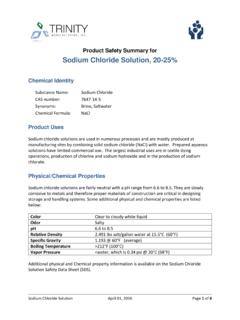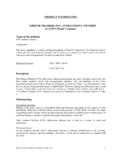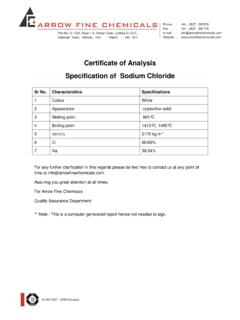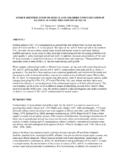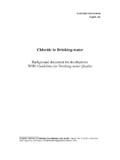Transcription of 7.6 The Sodium Nickel Chloride “Zebra” Battery
1 Battery Technologies The Sodium Nickel Chloride zebra Battery Introduction The zebra Battery (Zero Emissions Batteries Research Activity) is a Sodium Nickel Chloride Battery , manufactured in limited volume in Switzerland for EV applications. It is the only dedicated EV Battery in production in the world today. The technology was first developed in South Africa during the 1970s and 1980s. The major development then took place at AERE Harwell, who then entered joint development with AEG. AEG were later bought by Daimler Benz and then divested. This technology is only manufactured today by the company MES-DEA. GmbH, located in Stabio, Switzerland. MES-DEA bought the rights to the technology from AEG in 1999 after Daimler Benz divested itself of AEG in the late 1990s.
2 MES-DEA built a new $66M factory in 2001 to manufacture the Battery . The factory presently has an annual capacity of 30,000 units. Figure 40 shows the functioning1 of the zebra cell. FIGURE 40 zebra CELL. The -alumina ceramic electrolyte tube has the cross section of a clover leaf to increase the surface area available for ion transport between anode and cathode. The finished Battery package with control electronics has a specific energy density of 90 - 120Wh/kg (depending on format). Volumetric energy density is 166Wh/l. The theoretical specific energy of a cell is 1. From zebra Battery - Material Cost, Availability and Recycling , Dr. Galloway, Dr. Dustmann, MES-DEA GmbH, EVS 20, 2003. 104 Meridian International Research 2005. The Sodium Nickel Chloride zebra Battery 790Wh/kg.
3 The Battery is robust, potentially inexpensive, available in a number of large EV formats and is a well tested technology. This specific energy density is about the same or better than current generation LiIon Battery packs for EVs, available from SAFT or Sony. The Sony LiIon Battery pack in the 1999 Nissan Altra had a specific energy of 89Wh/kg. Existing SAFT LiIon EV modules have a specific energy of 110Wh/kg. In comparison, the 9kWh LiIon Battery provided by Valence Technology for retrofit into the Toyota Prius weighs 250 lbs, an effective specific energy density of only 80kWh/kg The zebra Battery will withstand at least 1,000 100% DOD charge/. discharge cycles including any type of partial charge/recharge and is also marketed by Rolls-Royce for demanding marine applications, including stand-by power in military submarines and surface vessels.
4 It is an extremely robust and rugged Battery capable of being used in demanding and harsh environments. On rapid recharge, the zebra Battery can be 80% recharged in 75. minutes. BMW used an earlier related technology ( Sodium Sulphur) on their prototype E2 electric car in the early 1990s. Sodium Sulphur technology was developed by Ford in the 1960s and discontinued in the 1990s due to corrosion problems. Mercedes Benz announced that they would launch an electric version of the A Class in 1998 equipped with the NaNiCl Battery . The Electric A Class would have had a range of 120. miles. The vehicle was not marketed. With the latest generation of zebra Battery , the range of the A Class EV would increase to 180 miles. Efficiency Comparison The major perceived drawback of the Sodium Nickel Chloride Battery is that it is a high temperature technology.
5 The Battery has to be maintained at an internal operating temperature of between 270 C and 350 C for efficient operation. While the Battery is being used, this causes no energy penalty since the internal resistance of the zebra Battery coverts resistive losses to heat with 100% efficiency. All batteries have internal resistance and in all batteries, this internally generated heat has to be removed by a cooling system to prevent overheating. Therefore in the case of the zebra Battery , the heat generated during operation can be used to maintain the temperature. However, when the vehicle is not in use, the Battery will start to cool down. After about 4 hours, external heat has to be applied to maintain the temperature. The Battery contains a heater which can be powered by the mains or powered by the Battery itself.
6 If the vehicle is left overnight it can be plugged in to both recharge it and to keep the Battery hot. If the vehicle is left for more than 4 hours in a location without access to a source of mains power, the onboard DC heater switches on to maintain the temperature. Meridian International Research 2005 105. Battery Technologies The key question in relation to other ambient temperature Battery technologies is therefore: How much more life-cycle electrical energy does the zebra Battery use than ambient temperature batteries? The Mendrisio Operating Trial Between 1995 and the present, the Swiss town of Mendrisio has been operating an EV trial programme. The programme started with Peugeot 106 EVs equipped with a 14kWh NiCad Battery pack, supplied by SAFT.
7 The electric motor is a 20kW DC motor. In 2001, a fleet of Renault Twingo electric cars powered by a zebra Battery started operations. The motor is a 36kW AC induction motor. The trial has been carried out under the auspices of the Swiss Federal Office of Energy and monitored independently by the local municipal authorities. An important difference between the two vehicles is that the Peugeot 106s are equipped with a small gasoline heater for the passenger cabin, while the Renault Twingos use a 3kW electric heater powered by the main drive Battery . Operating results from this trial were presented by MES-DEA at the latest Electric Vehicle Symposium1 in April 2005. The table below summarises the characteristics of the two vehicles. TABLE 15 MENDRISIO VEHICLE COMPARISON.
8 Peugeot 106 Renault Twingo Gross Vehicle Weight 1350 kg 1230 kg Empty Weight 1050 kg 980 kg Range at 50 mph 50 miles 75 miles Heater Petrol 3kW electric Battery 14kWh NiCad Motor 20kW DC 36kW AC. Avg. Energy Use Fleet Sample Size 15 5. Over a two year period, the Peugeot 106 used an average of of electricity from the mains per 100 km driven, or Over a 1. Mendrisio Operating Results using NiCd and zebra Batteries , EVS-21, Monaco, 2-6 April 2005. 106 Meridian International Research 2005. The Sodium Nickel Chloride zebra Battery 4 year period, the Renault Twingos have used an average of 100km delivered from the mains, or These figures for the Renault Twingos equipped with the zebra Battery include use of the Battery to heat the car in winter, not a trivial requirement in Switzerland.
9 In fact, the winter consumption averaged 25kWh/100km versus 20kWh/100km in summer. In addition, the Twingos were equipped with winter tyres which increase rolling resistance, while the Peugeot 106s were not. There was no difference between winter and summer energy use by the Peugeot 106s for these same reasons. With both vehicles, energy use per km decreases as the distance travelled per day increases. The thermal energy loss of the zebra Battery when not in use is about 90W or per day. However, in normal use the energy loss will be lower than this. Even if the vehicle was left unused with the Battery plugged in for an extended period of time, the cost of this electricity to keep the Battery at operating temperature would be minimal - less than 20 cents per day in Europe or the USA and would be equivalent to about 5 - 8 miles driving distance per day.
10 Conclusion In normal everyday use, it does not appear that the zebra Battery will use any more electricity than a NiCad system. There is so much variation in daily driving habits that the extra energy required to keep the zebra Battery hot does not appear to make much difference to overall energy efficiency. The zebra may in fact be superior to NiCad, since it has demonstrated slightly higher efficiency while also supplying cabin heat in winter and having higher resistance winter tyres. Cost Potential of the zebra Battery MES-DEA believe that the selling price of the zebra Battery would be $240/kWh in low volume production (10,000 units). At 100,000 units per year it is projected that the price would fall to $109/kWh. In 2003, MES-DEA published a cost analysis1 to justify these forecasts.



